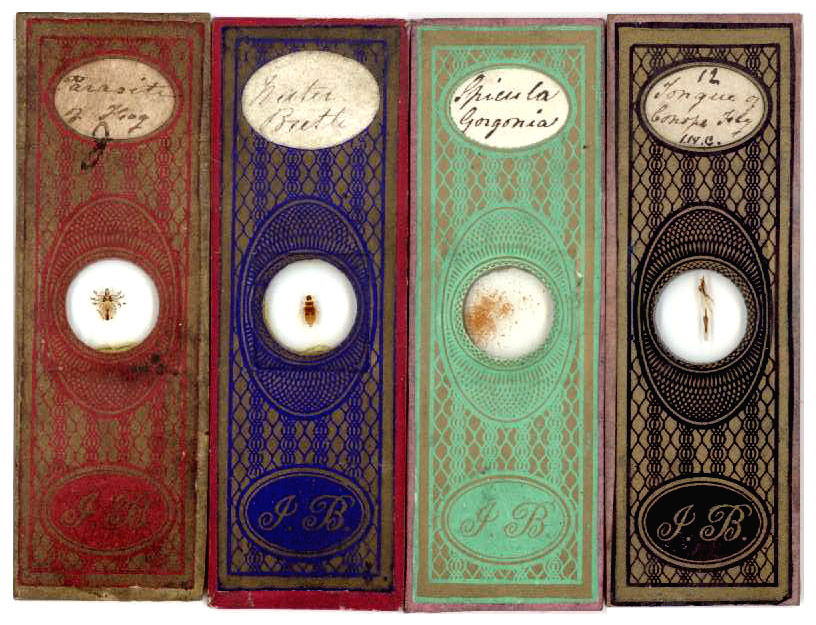
Figure 1. Examples of slides with the four known color variants of monogrammed JB papers.
John Barnett (“J.B.”), 1816 - 1882
by Brian Stevenson
last updated February, 2018
Considerably revised and expanded, but fundamentally based upon: Brian Stevenson, Brian Davidson, Peter Paisley, and Howard Lynk (2010) Nineteenth century microscope slide mounters JWB and JB: their work and their identities, Quekett Journal of Microscopy Vol. 41, pages 203-217
A substantial number of professionally-made microscope slides remain in existence which bear the monogram JB. Even more slides can be found that carry that maker’s handwriting, but used non-monogrammed off-the-shelf paper wrappers. Secondary labels from major Victorian-era microscopy supply houses are frequently found attached to JB’s slides. These indicate that JB was a major commercial producer of microscope slides during the 19th century. It had previously been suggested that JB was J. W. Burgess, based upon that man’s involvement with the Quekett Microscopical Club during the 1860s-70s. It was also suggested that the maker of “JB”-labeled slides also made slides with the monogram “JWB”. Additional research demonstrated that Burgess could not have been either JB or JWB. Mounter JWB was almost definitely James William Bond. Following is a discussion of JB’s microscope slides, and evidence that this important microscopist was John Barnett.
Four base colors of JB-monogrammed paper covers are known: red, blue, light green and black, each with gold ink (Figure 1). The initials “J. B.” appear in script in the lower oval. White oval labels were usually pasted over the upper oval, with the specimen description written by hand. The same handwriting appears on all JB-monogrammed slides. The monogram was often obscured by retailers with their own labels, but the handwriting can readily identify Barnett’s work. Other examples of his use of this paper can be seen in Brian Bracegirdle’s Microscopical Mounts and Mounters plates 9-C, 39-K, 40-C and 44-H.

Figure 1.
Examples of slides with the four known color variants of monogrammed JB papers.
The oldest known slide that was made by JB dates from November, 1854 (Figure 2A). It was owned by J.N. Furze, who habitually labeled slides in his collection with the date of acquisition and the maker’s name. Furze wrote “Barnett“ on this slide, confirming that the maker was, indeed, John Barnett.
Another early, datable slide by Barnett is shown in Figure 2B. It carries a secondary label from Andrew Pritchard, of 162 Fleet St., London. Pritchard closed his Fleet St. premises at the end of 1858. This slide is also significant in that it is one of the few items retailed by Pritchard for which the maker can be identified.
A slide with Barnett’s handwriting used a similarly patterned paper as the front cover, but lacking ovals (Figure 2C). Instead, a rectangular box was included at one end. A sheet of paper printed with this type of slide cover was included in Andrew Pritchard’s 1847 book Microscopic Objects. Numerous early microscope slides can still be found which used those papers, or variants such as the gold-on-blue paper used by Barnett. The slide shown in Figure 2C probably represents a very early product, predating the 1854 slide in Figure 2A. His monogrammed papers undoubtedly evolved from the pattern of this off-the-shelf paper.
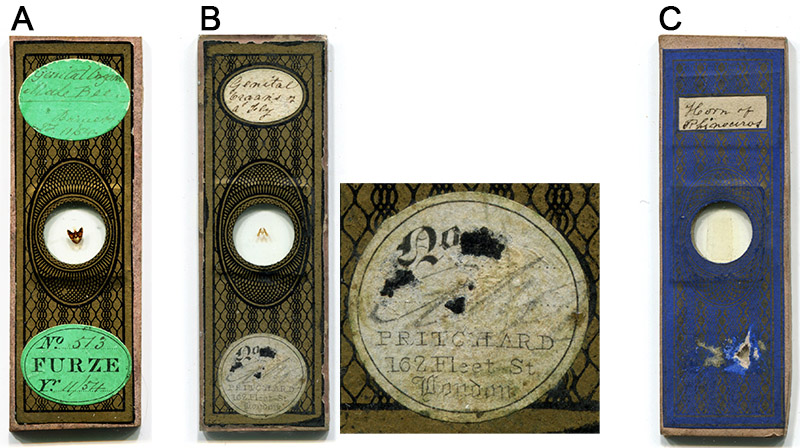
Figure 2.
(A) A slide that was once owned by John N. Furze, who added labels with the maker’s name, "Barnett", and date of acquisition, "11/54" (November, 1854).
(B) A slide bearing John Barnett’s distinctive handwriting, and a secondary label from Pritchard, 162 Fleet St. Andrew Pritchard occupied that location from ca. 1838 until late 1858.
(C) A slide bearing Barnett’s handwriting, with a cover paper similar to that published in Pritchard’s 1847 Microscopic Objects. This slide was probably made before the 1854 mount shown in panel A.
Some JB-monogrammed slides are known that also carry a second set on initials, “J.W.“, printed in the upper oval (Figure 3 and not shown). Those slides have additional handwriting from another person, who wrote “Powell 1859” across the front (presumably an owner). That date is consistent with the slides shown in Figure 2. The JB/JW slide shown in Figure 3 has two white oval labels affixed to its back, both of which bear Barnett’s handwriting. The other JB/JW slide, with a blue paper cover, had a white label glued over the upper, JW-imprinted oval, which we removed to examine the underlying paper. The handwriting on the gummed-on label is that of JB. Investigating further, when we peeled the white oval off a third, black-papered JB slide, only empty black space was found. These variations suggest that, during the 1850s, Barnett purchased slide papers which shared monograms with the presently unknown “JW.” At other times, Barnett purchased papers with the identical pattern, but made specifically for him and carrying his monogram only.

Figure 3.
Front and back views of a monogrammed JB slide that also includes the monogram “JW” on the cover paper. The reverse carries two oval labels, both with Barnett’s handwriting. A different hand added the date 1859. The identity of “JW” is unknown.
Barnett’s handwriting is distinctive, and several characteristics are consistent throughout his writing. Comparisons of the handwriting on JB-monogrammed slides with other microscope slides have identified a large number of his mounts, wrapped in several types of generic papers, or unwrapped (Figure 4). These non-monogrammed slides are very common in antique slide collections, and are frequently seen for sale in modern times. Their great numbers indicate that he was a substantial producer of microscope slides. Use of off-the-shelf papers instead of custom-made, monogrammed papers would undoubtedly have saved money for the maker. Such unsigned slides were probably produced by Barnett for sale by other firms. Indeed, many slides made by John Barnett carry secondary labels from retailers such as Watson and Son, Newton, Carpenter & Westley, Stanley, Robbins, Baker, and West, and from as far away as New Zealand.
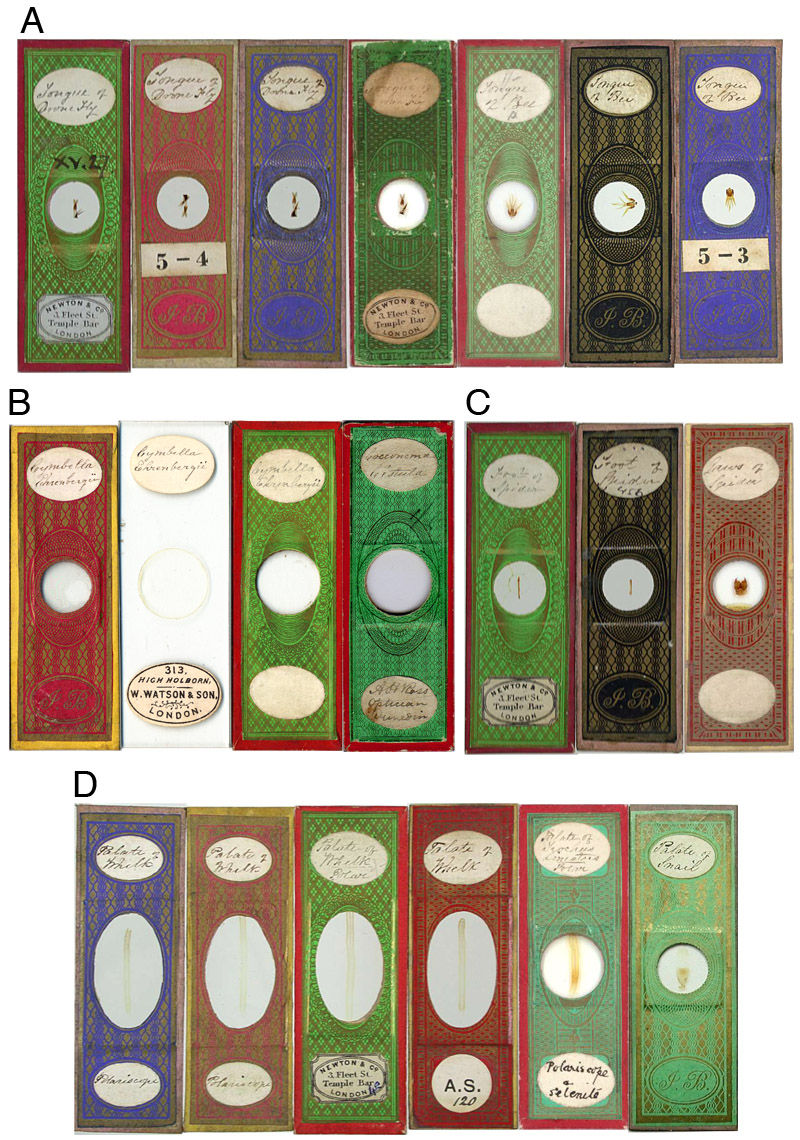
Figure 4. Monogrammed Barnett slides alongside similar slides with his handwriting and off-the-shelf papers.
(A) Four “tongue of drone fly” and three “tongue of bee.”
(B) Three examples of Cymbella ehrenbergii, and one of Cocconema cistula. The C. cistula bears a handwritten secondary label from Ross of Dunedin, New Zealand (ca. 1865-1900).
(C) Two “foot of spider” and one “jaws of spider.”
(D)Four “palate of whelk,” one “palate of Trochus lineatus,” and one “palate of snail.”
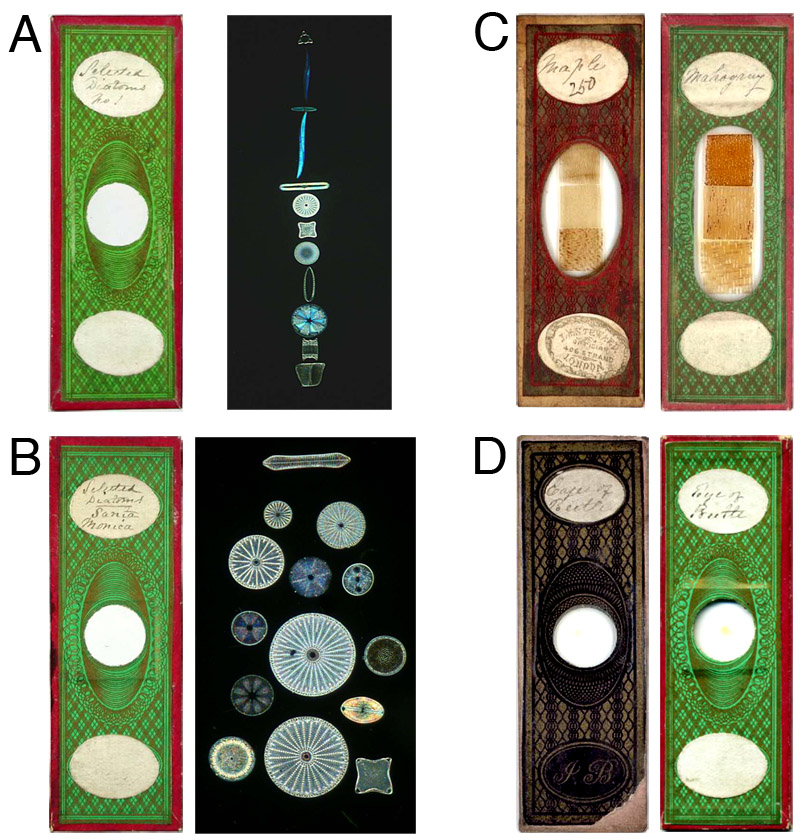
Figure 5. Some slides by JB corresponding to subjects known to have been prepared by John Barnett.
(A “Selected diatoms,” macroscopic and dark field specimen views.
(B) “Selected diatoms – Santa Monica,” macroscopic and dark field specimen views.
(C) Wood sections, “maple” and “mahogany.”
(D) Two examples of “eye of beetle.”
The above examples indicate that Barnett sold slides both with and without his identifying initials. Trade labels attached to some of his slides indicate that he sold his wares through a number of microscope manufacturers. These apparently included Edmund Wheeler, who sold microscopes and microscope slides under his name for several decades in the mid to late 1800s. In this case, it appears that Wheeler had JB label the slides as if Wheeler himself made them (Figures 6 and 7). Noting that JB had an reputation as an excellent mounter of arranged diatoms, and that Wheeler’s apprentice Ernest Hinton was later renowned for his diatom mounts, it is tempting to speculate that Hinton may have learned that art from Barnett. On a related note, another of Wheeler’s apprentices, his nephew Frederick Enock, wrote that his uncle sold slides made by several other mounters, including Charles and Amos Topping, and J.D. Möller.
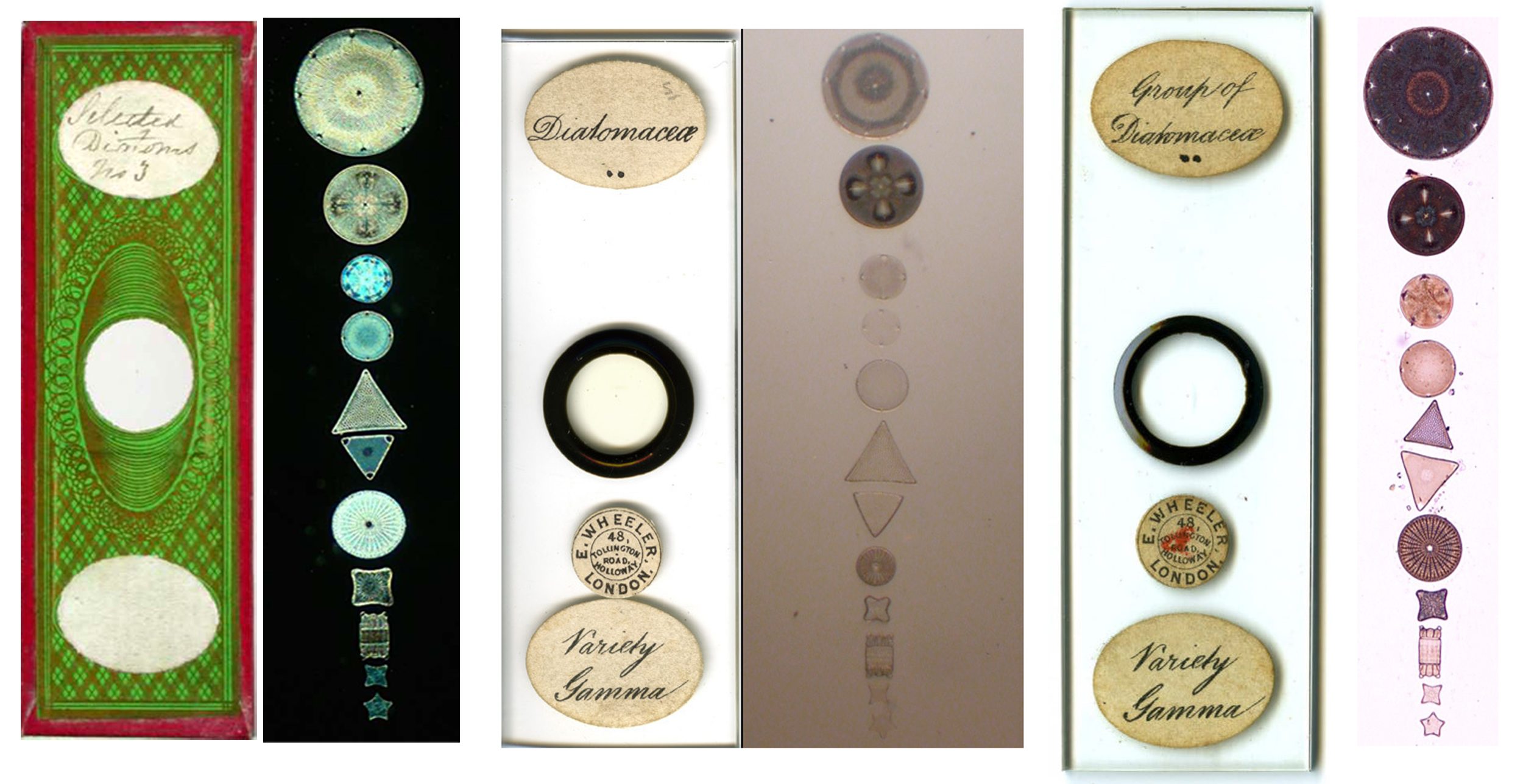
Figure 6. A slide by John Barnett of “selected diatoms 3” and two slides labeled by Edmund Wheeler as “variety gamma”. The Greek letter gamma corresponds with “C”, the third letter of the alphabet. Note that the diatoms in the Wheeler slides are of the same species as the JB slide (with a duplication in the middle slide). JB made numerous slides of this same arrangement, and with the same numbering designation, under his own label. These indicate that Barnett also distributed his work through Wheeler.
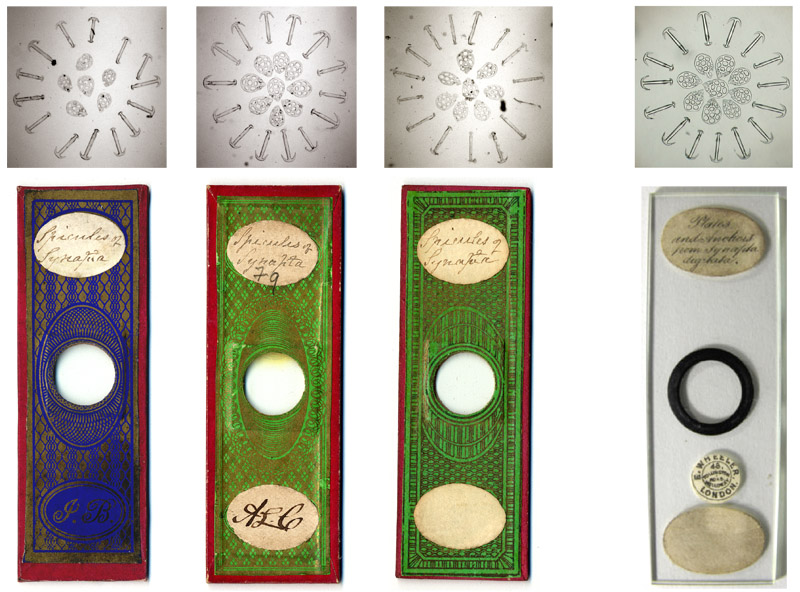
Figure 7. Another example of a slide labeled by Wheeler that was very likely made by John Barnett. To the left are three examples of arranged Synapta spicules labeled by Barnett, and to the right is a Wheeler-labeled example.
John Barnett was born during 1816, in Trowbridge, Wiltshire. He began his career as a microscope slide preparer rather late in his life. His 1839 marriage record listed his occupation as “shoe maker”. The 1848 birth record of his daughter Laura described him as being a “labourer”. On the 1851 census, John Barnett declared his occupation to be “brass finisher”, and lived in the Clerkenwell section of Middlesex, a major site for production of watches and jewelry. The 1856 birth record of son Henry also described the 40 year-old John as a “brass finisher,” with the family having moved a short distance to Islington. Since evidence indicates that Barnett was making slides by 1854 (Figure 2A), these references indicate that brasswork remained his major occupation at that time.

Figure 8. The signature of John Barnett, from the parish record of his 1839 marriage. There are many similarities between this signature and the handwriting on JB slides. Recall that this record was signed approximately 20 years before Barnett began commercially producing microscope slides.
At some time between 1858 and 1861, the Barnett family moved to Tottenham, then a much less urban area than were Clerkenwell and Islington. There may have been a connection between the move and John Barnett focusing more on making slides, although which prompted the other is unknown. Watchmaking involved numerous specialists working together, and those craftsmen clustered into centers such as Clerkenwell. Producing microscope slides, on the other hand, could easily be done by a single person in a semi-rural setting such as Tottenham.
Whatever the reasons for the move and change in occupation, for the 1861 census John Barnett considered himself to be a “microscopic anatomist”. Barnett displayed his work at the 1862 London Exhibition.
Barnett was later considered to be an expert at mounting diatoms, often in arrangements. An 1870 letter from a reader of the English Mechanic requested, “Can any of your numerous microscopic readers give me any information respecting the cleaning and preparing diatomaceous earths? I have been trying for a long time, and with very ill success. I have this week been examining some of Topping and Barnett’s preparations, and am disgusted with my own efforts, - the last named gentleman’s slides being astonishingly beautiful”. A response suggested putting “a drop of the water containing the diatoms on a slip, and having allowed the water to evaporate, may either mount them in water or dry, as he may elect. He might do worse than arrange the diatoms nicely in a circle a la Mr. Barnett, and then mount them in balsam. But as he probably will find this rather difficult—I for one can't equal this maker's slides—he may be content if he succeeds in keeping the diatoms separated, and does not float them out with the ‘wave’ of balsam”. John Barnett was obviously aware of these exchanges, since another suggestion in the English Mechanic from correspondent Henry Pocklington that one “must not expect to attain to Mr. Topping's pitch of excellence ‘all in a hurry’ ", led to an immediate follow-up note from Pocklington, “Mr. Barnett complains that I have ignored him in my reply to the query…a fortnight since; need I say that I used…Mr. Topping's name in a generic sense, and that nothing was further from my intention than to exalt one professional preparer of objects at the expense of another. As is well known to all microscopists, there are several gentlemen of nearly equal merit, each of whom excels in some one department. Mr. Barnett's preparations being certainly not inferior to those of Messrs. Topping, Norman, or any other of half a score mounters, place him out of any need for puffing”. This exchange also indicates fierce competition among slide preparers.
At the June 7, 1876 meeting of the Royal Microscopical Society, “the Chairman called attention to a donation from Mr. Hanks, of San Francisco, consisting of some diatomaceous earth from Santa Monica, near Los Angeles, and which seemed to be very rich in various circular forms. Some slides of diatoms from this material had been prepared by Mr. Barnett, and were upon the table for examination” (see Figure 5).
Barnett also acquired diatoms by exchanges with other microscopists, as indicated by this 1866 request in Hardwicke’s Science-Gossip: “Mounted Objects for unmounted Surirella nobilis or S. lata, Pleurosigma formosum, or P. fasciola. — J.B., 3, Whitehall-street, Tottenham”. A request in 1880 stated “First-class mounted slides given in exchange for the following : Peterhead deposit, Premnay and Cantyre plat, good gathering of Navicula rhomboides, Pinnularia alpina, P. lata, or animal fleas and parasites. — J.B., 24 Tilson Road, Tottenham”. In 1882, he offered “First-rate mounted slides given in exchange for material containing Arachnoidiscus in any variety, Aulacodiscus formosus, Glass Rope Sponge, and Meyerina claviformis. – J.B. 3 Gowrie Terrace, Cavendish Road, Tottenham”. The Whitehall Street address matches that of John Barnett on the 1871 census, the Tilson Road address matches his location on the 1881 census, and the Gowrie Terrace address is also on his 1882 death certificate. Barnett’s use of his initials in those requests might have helped ensure good quality exchanges, since respondents would know that they were receiving high-quality “JB” slides.
Additional publications of the time indicate some other types of Barnett’s specimens. In 1878, F.W. Griffin wrote on microscopic examination of beetle’s compound eyes, stating that he “can recommend Mr. Barnett as an excellent preparer of these ‘eyes’ (as well as of insects in general, grouped diatoms, wood-sections, &c.), and whose mounts may be relied on” (see Figure 5). An 1874 article by Griffin on sugar refining mentioned “we may appropriately take a section of the sugar-cane, which has been prepared for me by Mr. Barnett, the skilful microscopic mounter, of Tottenham”. An 1870 paper on making chemical slides for examination with polarized light suggested, “a pinch of most of the washing-powders used in the kitchen or laundry department of our domiciles, dissolved in hot water and allowed to re-crystallize in a thin stratum on a slip, and then mounted in balsam forms a splendid object, preferred by many to even the gorgeous salicines of Mr. Barnett”.
Lionel Beale included short lists of recommended microscopical specimen suppliers in his 1878 The Microscope in Medicine and his 1880 How to Work With the Microscope. Both lists included “Barnett, J.E., Whitehall-street, Tottenham.”
John Barnett died from intestinal cancer at the Middlesex Hospital, on November 22, 1882.
A colleague, writing in 1901, lamented, “Barnett . . . has never been replaced, for no one supplying objects commercially could mount diatoms so cleanly and so beautifully as he did, and it seems a thousand pities that men who have attained such excellence in a particular line should be comparatively poorly paid and seldom in affluent circumstances”.
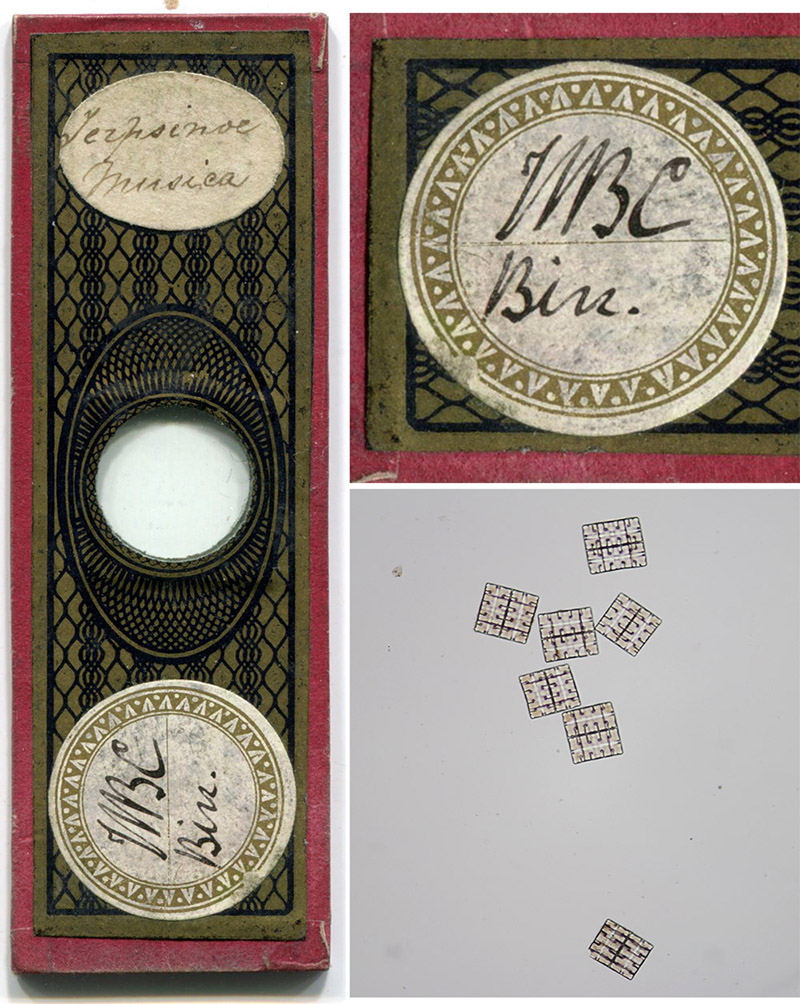
Figure 9. A Barnett slide with important provenance: the circular label with intials "W B C" indicate that it was once in the personal collection of William Benjamin Carpenter (1813-1885), microscopist, physiologist, zoologist, and the author of "The Microscope and its Revelations".
Acknowledgments
I thank my QJM co-authors, Howard Lynk, Brian Davidson, and Peter Paisley, for their friendship and collegiality; Steve Gill for his generous advice; and Carol King, descendant of John Barnett, for her generous help in assembling information on her ancestor
Resources
Beale, Lionel Smith (1878) The Microscope in Medicine, 4th edition, J. and A. Churchill, London
Beale, Lionel Smith (1880) How to Work with the Microscope, 5th edition, Harrison, London
Birth record of Emily Constance Barnett (1958) Middlesex, Islington district, vol. 1b, page 191
Birth record of Henry Alfred Barnett (1856) Middlesex, St. Luke Islington district, vol. 1b, page 527
Birth record of Laura Isabell Barnett (1948) Middlesex, St. James Clerkenwell district, vol. 3, page 117
Bracegirdle, Brian (1998) Microscopical Mounts and Mounters, Quekett Microscopical Club, London
Carpenter, William Benjamin (1856) The Microscope and its Revelations, First edition, J. Churchill, London
Census and vital statistics databases for England, accessed through ancestry.co.uk
Death record of John Barnett (1882) Marylebone, Middlesex
F.G. (1870) Letter, English Mechanic and World of Science, Vol. 12, page 23
Griffin, Frederick W. (1874) On sugar refining, Journal of the Society of Arts, Vol. 22, pages 611-620:252
Hardwicke’s Science-Gossip (1866) Exchange offer from J.B., Vol. 2, page 216
Hardwicke’s Science-Gossip (1880) Exchange offer from J.B., Vol. 16, page 216
Hardwicke’s Science-Gossip (1882) Exchange offer from J.B., Vol. 18, page 120
Hodgson, J. Spence, Frederic Enock, and Wilfred Whitten (1902) Edmund Wheeler, Ackworth Old Scholars' Association, report No. 23, pages 65-70
Marriage record of John Barnett and Sarah Yates (1839) St. Luke’s, Middlesex, Parish records
The Monthly Microscopical Journal (1876) Proceedings of societies, Vol. 16, page 52
The Monthly Microscopical Journal (1878) Microscopical experiments on insects' compound-eyes, Vol. 9, pages 182-183
Nuttall, Robert (2006) Marketing the achromatic microscope: Andrew Pritchard’s engiscope, Quekett Journal of Microscopy, 40:309-330
Official Catalogue of the Industrial Department (1862) Entry 2854, Barnett, J., 3, Whitehall-st. Tottenham. — Microscopic preparations. Class 13, Philosophical Instruments, and Processes Depending upon their use, pages 182-183
“An Old Lanternist” (1901) Occasional notes, The British Journal of Photography, Vol. 48, supplement, pages 3-4
Pritchard, Andrew (1847) Microscopic Objects, Whitaker, London
Pocklington, Henry (signed H.P.) (1870) Letters, English Mechanic and World of Science, Vol. 12, pages 46, 90 and 154
Pocklington, Henry (signed H.P., H.) (1870) Micro-polariscopy, English Mechanic and World of Science, Vol. 12, pages 337-338
Stevenson, Brian, Brian Davidson, Peter Paisley and Howard Lynk (2010) Nineteenth century microscope slide mounters JWB and JB: their work and their identities, Quekett Journal of Microscopy Vol. 41, pages 203-217